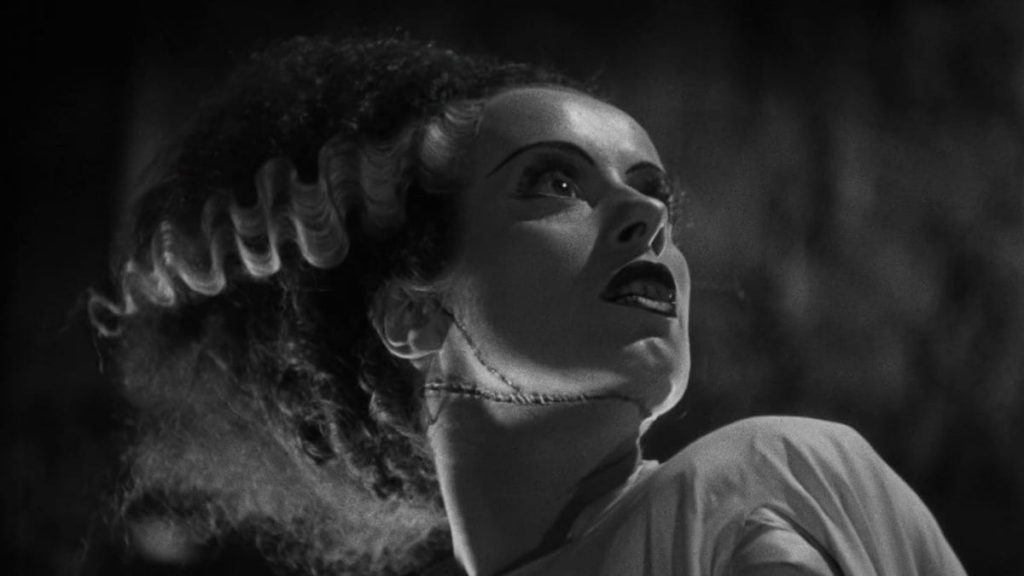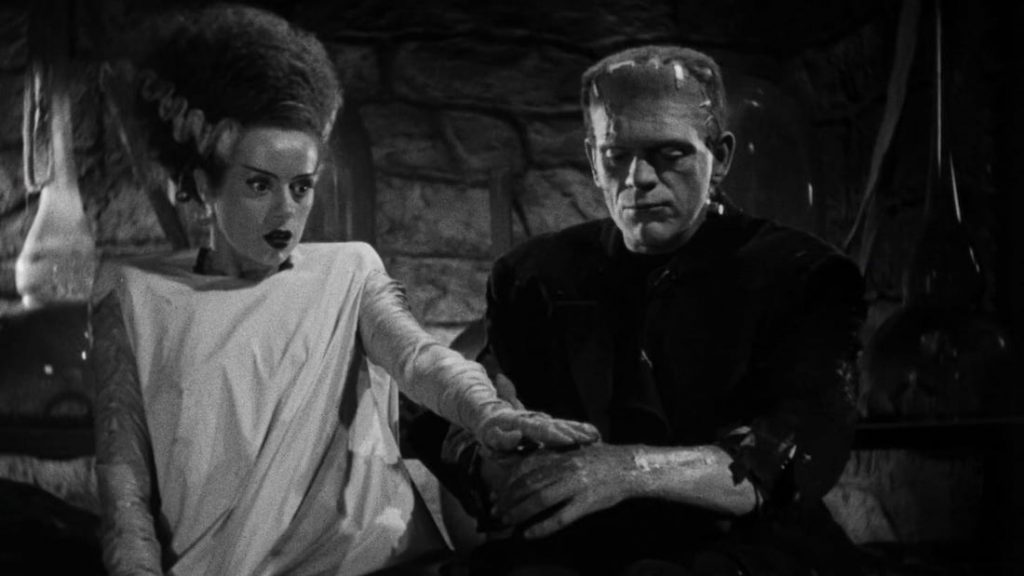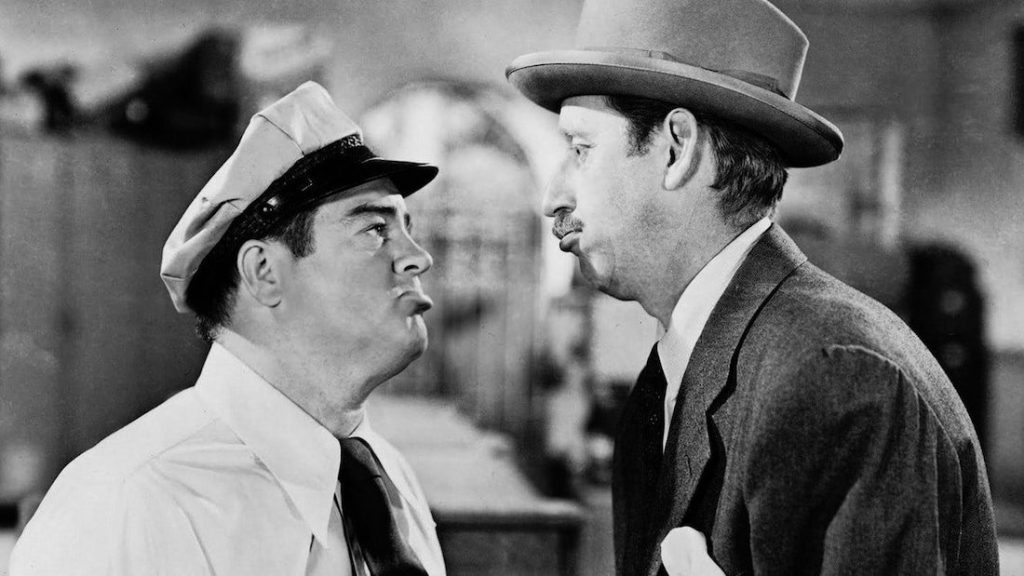THE BRIDE OF FRANKENSTEIN (1935) • ABBOTT & COSTELLO MEET FRANKENSTEIN (1948)


To celebrate the 90th anniversary of the birth of Universal’s classic horror characters, YouTube channel Fear: The Home of Horror are making seven of their vintage movies free for a week from 15 January 2021:
Below are our reviews of two of these offerings…


Dr Frankenstein, goaded by an even crazier scientist, builds his monster a female mate.
We live in a post-‘Dark Universe’ era. Watching Universal fumble reviving their classic monsters has been more fun than the resulting films themselves. Then Leigh Whannell’s The Invisible Man (2020) had the revolutionary idea of being foremost a standalone horror, unencumbered by setting up a larger universe like The Mummy (2017).
90 years ago, a similar surprise hit called Dracula (1931) practically saved the studio singlehanded, so Universal continued tapping that vein with the instant classic Frankenstein (1931) directed by James Whale. A sequel was all but guaranteed…
The New Adventures of Frankenstein: The Monster Lives! is an incredibly dumb title, but it was one of several scripts rapidly pitched for a follow-up. Whale’s opinion was “it stinks to heaven” and he had no interest in returning for a Frankenstein sequel, but after he directed The Invisible Man (1933) the studio had nobody else in mind. William Hurlbut and eight uncredited writers decided to adapt the untold portions of Mary Shelley’s source novel…

Bride of Frankenstein reunited Whale with Colin Clive as Dr Henry Frankenstein and Boris Karloff as the Monster; all three delivering the same incredible electricity as before. Picking up from the climactic windmill inferno, both leads survive their near-death experience. Late, Henry is nursed back to health by his new wife, Elizabeth (Valerie Hobson), and vows to make up for his ignored love… while the Monster endures persecution from violently escaping dungeons to appreciating the soulful violin of a blind hermit. The introduction of an original character, Dr Pretorius (Ernest Thesiger), ensnares the darker humanity in both and draws them together for the dangerous recreation of the Monster.
Sequels often detrimentally repeat the successes of their predecessors. The secret to Bride lies in reinvigorating the dynamics of Henry and the Monster; their continued struggle between good and evil as man playing God and the Christ-like sufferer is reignited by the sly devil Pretorius. Shown acts of kindness and cruelty, they’re both given a second chance and yet return to one another; the lonesome Monster would force creation of another scorned and feared aberration like himself while Henry sees these learnings of cunning speech and painful emotion only as signs that his work would be successful.

If the Monster is a question in autonomy, then the Bride (Elsa Lancaster) is the perfect response from a feminist perspective. Women through cinema history have been a goal to be earned by male leads. Henry and Pretorius simply assume a feminine creature must be easier to control, but the sympathetic Monster is ideologically blinded in his own plight. We suffer along with the Monster rejected by the townsfolk, we feel immense relief as the blind hermit treats him indifferently only, and yet his instinctive actions here betray our solidarity. In a final act of irony, the Monster attempts to be human only to become monstrous in punishing another made in his image when she exhibits the first reaction of her new reality.
What significance lies then in the double casting of Lancaster as Mary Shelley? A chance to not only articulate but become the very creator of this entire two-part story, adapted from the original novel wherein the Bride was never completed. Here, the actress not only gets an opportunity to respond to the heteronormative quest in disgust and fury through animal like screeches ,but to shock and delight the real-life men of Percy Shelley and Lord Byron in the wraparound. Henry and the Monster destroy themselves despite their better nature and drag the Bride down as their cause, but it is the woman who endures and uses the tale of their failure for her own historic success.

I drop the word heteronormative because of the still bewildering acceptance of openly gay director Whale during the 1930s, as well as the bisexual suppositions of both Clive and Thesiger leading do a great deal of critical appraisal. Whale elevated the tragic figure of the Monster from being just that, a monster, and we must assume the same complex consideration went into Bride. Henry and Pretorius’ unwavering passion for science, the Monster’s aching yearning for acceptance, and the fetishization of a created woman versus the natural marriage of Elizabeth all meld into a deep emotional exploration. In the novel, Elizabeth is killed and a dropped film development would’ve had her literal heart used for the Bride providing the perfect female ‘beard’ to bring Henry and his Monster together at last.
Bride of Frankenstein not only serves as one of cinema’s perfect sequels but a mesmerising experience all in itself. Universal would of course follow the money and continue with an incredible eight further adventures of Frankenstein battling Dracula and the Wolf Man. With many of them being worthy blockbusters, the creative talents of Whale, Clive, and even Mary Shelley would be sorely missed. Karloff remained for one more but the Monster lived on with new bodies. Henry’s fears that Frankenstein and the Bride would dominate the world with more of their kind really did come true.
USA | 1935 | 75 MINUTES | 1.37:1 | BLACK & WHITE | ENGLISH


The Wolf Man tries to warn a dimwitted porter that Dracula wants his brain for Frankenstein monster’s body.
During Universal’s eight Frankenstein movies an entire world war happened. House of Dracula (1945) premiered as the Nuremberg trials were beginning, and as the family of history’s greatest monsters were killing each other, Dracula, the Wolf Man, and Frankenstein’s Monster were doing that too. The US would be victorious but shaken in the years to follow but a natural reaction to horror is laughter. The fear was gone from Universal after milking their properties dry by this point, and if their classic monsters were becoming jokes then the studio was going to capitalise…
Abbott and Costello Meet Frankenstein tells the fairly simple story of Wilbur (Lou Costello) and Chick (Bud Abbott), men assigned to transport the “remains” of Dracula (Bela Lugosi) and Frankenstein’s Monster (Glenn Strange) to a house of horrors, only for their cargo to have plans of its own. Blamed for the disappearing bodies, the comedy duo are caught between Larry Talbot (Lon Chaney Jr.), claiming to be the Wolf Man, and Costello’s new dame Sandra (Lenore Aubert), who secretly plans to place his simple brain into the Monster for Dracula’s control.

Remember when Jeremy Renner went on Saturday Night Live to play Hawkeye for a sketch? How about when the entire Avengers cast starred in a full feature parody starring the Wayans? I still double take in appreciating just how official this film is cemented into Universal’s Classic Monsters phase; not just a silly side project but the end of an era. There was still The Creature from the Black Lagoon (1954) but this was their final big monster mash. Imagine the Russo brothers thinking Avengers: Infinity War (2018) was lacking something and adding Adam Sandler and Kevin James to headline Avengers: Endgame (2019)!
Bela Lugosi came back for the second and last time as Dracula! Lon Chaney Jr. returns for the fifth time as The Wolf Man (1941), and his role as Talbot only ever returned in crossover events Frankenstein Meets the Wolf Man (1943), House of Frankenstein (1944), and House of Dracula (1945). For those expecting Boris Karloff, Glenn Strange instead returned as the Monster from the prior two House movies… so him and Karloff actually have an equal three films apiece.
Seeing these icons do battle here, for the final time, is all the more impressive after charting their many strange paths crossed in Universal. Chaney Jr. starred as four monsters; Wolf Man, Ghost of Frankenstein (1942), The Mummy’s Tomb (1942), and Son of Dracula (1943), all in three years! Lugosi was in more Frankenstein movies than Dracula; as Ygor his brain and voice would be put in the Monster (played by Chaney Jr.) in Ghost and then Frankenstein (Lugosi) would fight the Wolf Man (Chaney Jr.) in Frankenstein Meets the Wolf Man (1943)! Stranger still, Karloff was done with Frankenstein but later starred in Abbott and Costello Meet the Killer, Boris Karloff (1949)!?

With all this nonsense it was high time two bumbling comics were dropped into the midst to poke fun at the veritable Frankenstein’s monster of movie franchises. But if we’re talking nonsense… how about that title? Abbott and Costello never meet Dr Frankenstein! And for a classic double act it sure seems Costello takes centre stage here; not just with the best comic moments but the entire plot revolves around him with two women and two monsters all vying for his attention.
The spectacular finale is a wonderful commitment to the genre by director Charles Barton, with exploding laboratories, glorious acts of defenestration, and monsters brawling through a Gothic mansion. All this is happening as Abbott and Costello charge from one slapstick moment to the next; from being strapped to a gurney and pinballing between the Wolfman and Dracula or barricading a door and leaning against it only for the Monster to open it with a pull. Hilarious, sure, but always Costello at the forefront.

Any comedy fan worth their salt must’ve at least heard of their classic ‘Who’s on first’ routine; clearly demonstrating how the two man comedy act builds such a fast-pace rapport that the laughter encapsulates both performances. The script pacing from long-time collaborator John Grant is dragged down by the moody dramatics of the monsters, who all behave very seriously, and is improved in later attempts—particularly Meet the Invisible Man (1951). The concept of two comedians in a serious horror is great, but the material repeats tired old story beats rather than subvert them, which hampers all the performances.
Lugosi coming back is a wonderful treat but it’s never given a chance at comedy and his threatening presence is neutered. Chaney Jr. has consistently acted his heart out with the always sympathetic Talbot, which produces solid comedy now the nonbelievers are actively stumbling around him during a full moon. The two actresses, Aubert and Jane Randolph, surprisingly get an intriguing play of two manipulative professionals taking advantage of the infatuated men but are pretty much forgotten once the monsters start fighting. The two most underwritten parts are a doctor (Charles Bradstreet) becoming the default hero by the end, and the Monster himself!
It’s true that Costello said his five-year-old daughter could write a better script, but nevertheless, everyone commits in the end, which serves to create a fascinating curio in early Hollywood franchising. There’s plenty enough of the tropes played straight for any classical horror fan to enjoy and the comedy will entertain those who don’t care why these monsters are all fighting.
USA | 1948 | 83 MINUTES | 1.37:1 | BLACK & WHITE | ENGLISH

directors: James Whale (Bride) • Charles Barton (Abbott & Costello).
writers: William Hurlbut (story by William Hurlbut & John L. Balderston; premise based on the novel by Mary Wollstonecraft) (Bride) • Robert Lees & Frederic I. Rinaldo (based on characters created by Mary Shelley, Bram Stoker, Curt Siodmak & H.G Wells) (Abbott & Costello).
starring: Boris Karloff, Colin Clive, Valerie Hobson, Elsa Lanchester, Ernest Thesiger & E.E Clive (Bride) • Bud Abbott, Lou Costello, Lon Chaney Jr., Bela Lugosi & Glenn Strange. (Abbott & Costello)
Both these films are free to watch on YouTube from 15 January 2021, together with the aforementioned other five Universal classics, courtesy of Fear: The Home of Horror.
Each film will be freely available on YouTube for a week, and can then be purchased digitally at a discounted price to celebrate Dracula and Frankenstein’s 90th anniversary.
